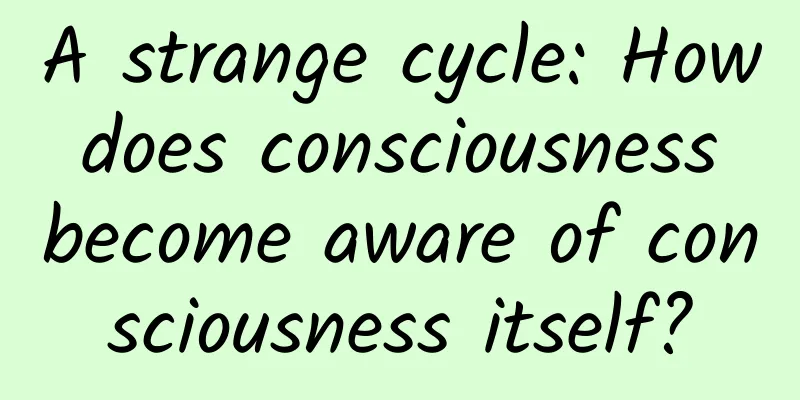A strange cycle: How does consciousness become aware of consciousness itself?

|
Leviathan Press: The academic community has always been full of controversy over the definition of human consciousness, which is often related to how to define "self": when we were babies, when did we learn to recognize that the image in the mirror was our own? If we follow the path of the mirror test, we will find that even those creatures that do not pass the mirror test can still be identified as having a certain state of consciousness (neurophysiological matrix): such as cats and dogs. Therefore, some people, such as Daniel Dennett, "bypass" the definition of consciousness and believe that consciousness is just an illusion. It is futile to try to explore the "immaterial" consciousness with existing scientific methods. Of course, more importantly, from a linguistic point of view, we also have a seemingly insurmountable barrier: Can things themselves be described in descriptive language? The feeling of existence may be just that, a feeling. —Ben L. Callif Philosophers have long thought about consciousness in a realm separate from physical reality. Over the past century or two, however, biology has moved closer to the study of consciousness. With the rise of neuroscience and the discovery of genetics, it has become increasingly important for scientists to become philosophers, and vice versa. But there remains a large cognitive gulf between philosophy and science. Biology, for example, is firmly rooted in the physical world, in which all phenomena can be explained by deterministic, causal factors. In this field, organisms are viewed as small parts of a larger machine and can be studied like machines. But in this way, consciousness occupies an immaterial space that is inaccessible to the probes of scientific substance. This is an unfortunate situation, because we cannot understand the world except through the "lens" of conscious experience. In biology, subjectivity is either ridiculed or treated as an indescribable, disembodied mind. So how can we balance these two extremes? In this article, we will explore the ineffable consciousness in the context of biology. The traditional view of consciousness is that it is not just a metaphorical space of inner experience, but a literal entry point, like eyes, ears, mouth, and nose. These sensory openings transmit external reality to the inner world. They transform the objective into the subjective, analog information into digital sensations, and external movements into internal emotions. This view of conscious sensation as a transition from a "physical" dimension to a "mental" (or pure information) dimension is so brief that it is considered one of the greatest mysteries of all time. Even many neuroscientists and philosophers who study consciousness believe that there is an “immaterial”, logically indescribable level of the subjective world, called “qualia”. The broad definition of this quality is not controversial, because it refers to the phenomenal level of subjectivity. In other words, even if no two people can see exactly the same color, who can deny that smells, tastes, and textures exist and have an impact on our behavior? However, philosophers believe that some organisms, such as plants, do not have feelings because “any thoughts that arise in their minds cannot have a direct impact on their beliefs or desires, because they have no beliefs or desires.” Perhaps this is a nitpicking and simplistic interpretation of "beliefs" and "desires." But my definition of life as "a self-sustaining process of organizing disorder into order" suggests that all living things have at least two "desires": survival and organization. According to this definition, plants certainly have "qualia" because every process within them is for survival and maintaining balance. Plants even use many of the same proteins as humans to process sensations and generate complex behaviors based on those sensations. But plants almost certainly experience the world in a very different way than we do. We cannot experience plant life directly, but it is unreasonable to think that plants have no subjective experience at all. In the evolutionary web, humans are related to plants as we are to all living things. (science.sciencemag.org/content/361/6407/1112) It’s clear that plants can respond to their environments in meaningful and direct ways. For example, they grow toward the sun, ward off predators, and sense the changing of seasons. Plants sense, process, and respond to their environments in such complex ways that a new field of study has begun to flourish, called plant neurobiology. This is a new disciplinary framework that considers plants to be intelligent and social organisms. The question of whether plants feel (or whether they feel at all) is up for debate, but if we doubt their ability to react and choose, why not doubt these abilities in humans as well? This kind of indeterminate reasoning about things we simply cannot observe makes discussions about human consciousness elusive. The main difficulty in discussing consciousness is that no logical system (including consciousness) can truly define itself. In other words, there is always one thing that descriptive language cannot describe: things themselves. This is easily demonstrated by paradoxical self-references, such as: “This sentence is false.” We can probably construct these non-tautological statements (a contradiction; a statement that says if false it is true, and if true it is false) in any symbolic system. Consciousness is like any other self-referential system - it is necessarily incomplete because it must be constantly updated to include itself within itself. Once you have a new experience or learn something new, you must integrate it into your identity. This new identity then needs to be integrated into another new identity, which in turn needs to be integrated into another new identity, and this continuum can continue. This infinite recursion and self-referential logic is called a "strange loop". What happens when you use a camera to shoot the content on the screen? This example clearly explains the "strange loop" phenomenon. Any changes detected by the camera will produce ripples in the layered image in the form of infinitely decaying waves. In a way, the nature of consciousness cannot be defined because it is the absolute reference point for all possible definitions - it is the key that connects language and self-referential systems. Some Buddhist sects refer to this undefinable nature of consciousness as Zen. The distinguished philosopher Douglas Hofstadter describes Zen this way: We cannot describe what Zen is. No matter what language you try to enclose Zen in, it will resist and overflow... The attitude of Zen is incompatible with language and truth, or at least no language can capture its true meaning. The elusive Zen concept of the ineffable consciousness is also known in Chinese philosophy as the Tao: the essence of experience, where nothing is something and something is nothing. Zen philosopher Alan Watts puts it this way: The present moment is infinitely small; it disappears before we can measure it, but time exists forever. This movement and change is called Tao... One cannot escape the infinite Tao, nor can one catch up with it; there is no way to it, nor a way away from it. Tao is Tao, and you are Tao. Consciousness, Zen, and the Tao. Whatever we call it, this indefinable absolute reference point is like a black hole at the center of self-consciousness, binding together the entire dimension of experience with its inescapable pull: "The Tao is the Tao, and you are the Tao." To be clear, consciousness is not about identity or memory. The relationship between them should be more like this: humans are aware of our memories and identities, just as we are aware of someone tapping us on the shoulder. Contrary to traditional conceptions, consciousness is a transcendental essence that is rooted in all experience: the feeling of being, the presence behind all perspectives. Moreover, in addition to the objects, people, and surroundings that consciousness constantly simulates, human consciousness is also simulating itself. This concept of self is: 1) all other representations, 2) the representer itself, 3) the representation of the representer's representation, and so on to infinity. Despite being the most universal trait among organisms that can communicate, consciousness can be a difficult topic. Language is often considered an integral part of the human experience of consciousness. But consciousness is more than the complexity of language. The thousands of human languages are made up of countless unique words. Yet all words share one common trait - they all have the property of being self-referential. All words are defined by another word, and each word defines itself through that definition. In other words, a word is only a word if it has meaning, meaning that it refers to some "thing" or "concept" in the non-linguistic realm. To visualize this, imagine that each word is connected to every other word in a giant, two-dimensional web of definitions. Every word in this web must have a connection to something outside of this two-dimensional web. The web maintains its structure because it is anchored in a separate reality - a dimension that exists above and outside of the web of language. Consciousness is often confused with language because it shares the self-referential nature of words, but consciousness is also easily separated from language in some ways. Humans who speak different languages share many things in common with each other, with animals, and with pre-verbal infants. A prime example of this commonality of consciousness is emotion, the ability to be prepared and responsive to certain situations. Antonio Damasio, a professor of psychology, philosophy, and neurology, defines emotion this way: The biological function of emotions is twofold. The first is to produce a specific response to an inducing situation. For example, in animals, their response (to different external environments) may be to flee, to remain motionless, or to beat the enemy to a pulp… The second biological function of emotions is to regulate the internal physiological state of the organism in order to prepare for a specific response. For example, increasing blood flow to the leg arteries so that the muscles can get extra oxygen and glucose when running fast; or changing the heart and breathing rhythm to prevent sluggish movements in an emergency. By this definition, an emotion is a physiological movement with direction and purpose—the ability to change itself in response to the environment. As mentioned earlier, plants can sense sunlight and grow toward it. For example, when we feel threatened, our heart rate and breathing speed up in preparation for fight or flight. These changes occur whether we are aware of the threat or not. Even if we don’t know why certain emotions occur or how to explain them, we often sense these changes (“Why are you crying?” “I don’t know! I’m just so happy!”) This is an interesting separation of emotions and feelings. Emotions are bodily responses, but feelings are the subjective perception of those emotions and are what allow us to regulate our internal states. In this framework, feelings are just one type of emotion: an internal emotion in response to an external emotion, a meta-emotion. The conscious perception of an emotion occurs in the form of a related feeling, such as fear of a looming shadow behind you, anger at the way that person is looking at you, or general anxiety for absolutely no reason. This is where things get interesting. Emotions are themselves a form of self-awareness and a form of self-reference, because adaptive responses to external changes require some functional distinction between the individual and its environment. This emotional ability to respond, adapt, and survive is one of the most important components of evolution, and therefore of life. Emotion is essentially a synonym for behavior—the way an organism uses its body to respond to its environment. In this context, emotions are necessary for life, and more complex emotions give rise to a wider range of responses to changes in the environment that could be life-threatening. Following this logic, the ultimate adaptive tool is the ability to respond to responses—that is, perception. This capacity for infinite recursion and self-referencing reaction is what seems to have driven the extraordinary progress of human intelligence. Emotions are an essential component of even the most basic forms of life, and the complexity of emotions is what we often attribute to "higher" consciousness or self-knowledge. While any emotion is a form of self-awareness, human consciousness is a more explicit and expressible self-awareness that arises from feeling an emotion. Metaphorically, being aware that we are conscious allows us to step aside and become an “agent” of our own internal reactions. In this case, consciousness is a circular chain of emotions: emotions of emotions of reactions to emotions. Consciousness is the process of experiencing our own feelings from different perspectives, which creates a chain of experiences – transforming external events into internal reactions, emotions, feelings, and ultimately, consciousness… By Ben L. Callif Translated by Pharmacist Proofreading/Sue Original article/medium.com/awake-alive-mind/consciousness-a-strange-loop-of-emotion-7be403041e61 This article is based on the Creative Commons Agreement (BY-NC) and is published by Pharmacist on Leviathan The article only reflects the author's views and does not necessarily represent the position of Leviathan |
<<: When is lettuce in season? Is lettuce a carbohydrate or a vegetable?
Recommend
Can naturally small breasts become bigger?
The breasts are an important part of a woman'...
Characteristics of gynecological inflammation bleeding
In our lives, many women suffer from gynecologica...
Two months after egg retrieval, the transplant process
In vitro fertilization has become a method of pre...
What is causing vaginal moisture?
Many women in their daily lives always feel a wet...
5 months pregnant with milk
Milk is the liquid nutrient produced by pregnant ...
Why are my labia majora swollen and painful?
Vulva swelling and pain are quite common in life....
There is blood in my underwear when I am pregnant
Some pregnant women will experience a small amoun...
How to check cervical polyps
Cervical polyps cannot be detected at the beginni...
How to correct round shoulders for girls
Round shoulders are the same as hunchbacks, which...
What are the factors that affect follicle development?
Poor follicular development is a problem that tro...
What to do if you have vulvar inflammation? These methods are simple and effective!
If a woman develops vulvitis, there are three mos...
How to take care of women's private parts
Women's bodies are very delicate. Various gyn...
If you have hearing loss, which is the right choice: a hearing aid or a cochlear implant?
《Cotton Swab Medical Science Popularization》 Gong...
19-year-old boy suffers from Alzheimer's disease, test yourself now!
Recently, a paper by Capital Medical University P...
What causes a woman's buttocks to sag?
Most of the female friends have a very bad lifest...









